HMCS Haida Tales
By Steve Stevenson
After learning the ropes on HMCS Huron, I was fortunate to join the crew of HMCS Haida, another Tribal-Class Destroyer. Apart from having to meet and work with an entirely new crew, my work routine was much the same. The only difference being, I was a more senior Engineering Mechanic, second-class (stoker) and my duties changed accordingly.
For instance, on HMCS Huron I had worked in the boiler rooms where steam was generated to power the turbines and the steam-driven auxiliary equipment. Now I worked more in the engine room and assumed additional duties. Namely, I was qualified to work as the Engineer’s Writer. This position involved keeping an engine room register, ship's fuelling records, general book keeping, handling correspondence, filing, etc. I quite enjoyed this job.
My new duties were more physically challenging and included working in the ship's laundry. The laundry was located in a 10 by 10-foot steaming-hot cramped room containing a huge rotary drum washer and a rotary drum dryer. There was also a steam uniform presser. Twice a week my mate and I had to wash and dry the work clothes, jackets, bedding, etc, then iron uniforms for the officers and crew numbering 270 people. The clothes were brought to us in huge heavy bags and when washed had to be sorted and placed in a small bag for each person. Fortunately, all clothes were permanently marked with the names of the owner. Thankfully, this was an occasional duty which I shared with other stokers.
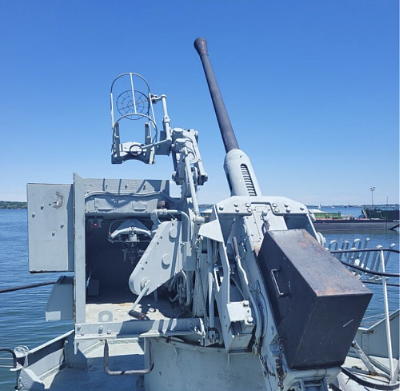
Haida's 40mm Single-Mounted Pom-Pom Gun (one of two).
For the record, due to the fact that stokers comprised one quarter to one third of the crew, we were cross-trained to operate the 40 mm single-mounted anti-aircraft pom-pom guns on the Tribals. I remember strapping into the seat of the gun, which swivelled 360 degrees, and then firing at a target being towed by an aircraft out at sea, when we were on maneuvers. It was tricky – one mate fired too close to the aircraft and it dropped the target and flew away.
Another notable stoker fact, that due to our large numbers and the fact that we slept, ate and worked below deck, is that in wartime when our ships were seriously shelled or torpedoed, the stokers survival rate was virtually zero.
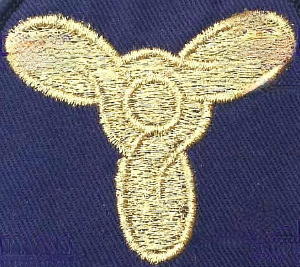
The 'stoker' name was derived from the early days when ships' engines were steam-driven and the boilers were coal-fired. Coal had to be stoked by the boiler crew to create the best fires in order to obtain maximum speeds. My Engineering Mechanic (stoker) badge, sewn on my uniforms, was appropriately a propeller.
A ship-board tale would not be complete without a few words, namely 'sea legs'. When I boarded my first ship I didn’t really know what these words meant, but I soon found out. My experience on water prior to that was in a row boat with my father fishing for perch in the sun, on a flat, fresh-water lake. Many people know that learning to get around in a boat in wavy lakes for a hour or so is not a big deal, but being out on the ocean in a naval destroyer on the high seas, often stormy, for up to four weeks is another story entirely.
This situation hit me like a ton of bricks. There was zero mention of this in basic training at HMCS Cornwallis. My first encounter on how to deal with the constant ship motion was on my previous ship HMCS Huron. On that occasion I had to learn fast. I soon had to consult my mates when we were well out to sea. Everyone was quite helpful and I was given all of the regular advice – don’t fixate on the waves, watch the horizon to stop the nausea that you soon begin to feel. If your appetite disappears, stick to crackers and peanut butter for a while and go up on deck and sit mid-ships by the ship's funnel where wave action is minimized. I have to say that I was not bothered by sea sickness for long and I was soon over it. I had obtained my sea legs. WHEW!
It has to be mentioned that after developing sea legs, you are still not out of the woods. If you are out at sea for many weeks, your body becomes accustomed quite nicely to the wave action, but when you reach a port and go ashore things change abruptly. My first experience was actually quite funny. When I reached the jetty on that occasion, I began to stumble as I walked. What the hell! I soon learned that it would be a couple of days before I had my 'land legs' back. It wasn’t a one-time thing either, every time we were out at sea for a long period I had to again get my land legs back. This whole development was quite a lesson.
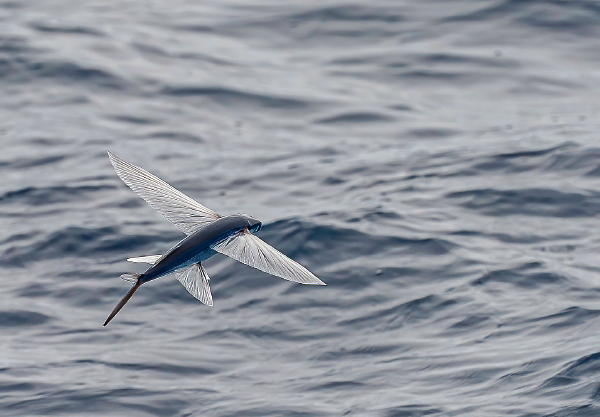
On HMCS Haida I had a few new experiences. For instance, I learned a little about fishing in the ocean, with a flashlight. I learned that some fish can actually fly well above the water in schools. During their brief flight if they see light, some will fly towards it. It doesn't take too long to have enough fish for a dinner. Simply pick them up from the ship's deck and grab a frying pan.
I also learned that although you're hundreds of miles out at sea, you are hardly ever alone. Sea creatures are always watching you.
Namely, while sitting at the bow of the ship watching the waves one sunny day, I realized I was not alone. A pod of dolphins suddenly
 appeared in the ship's bow wake ahead of the ship. They were thoroughly enjoying themselves and were having no trouble with the wake.
They swam for the longest time without tiring. Then suddenly, they were gone. I guess they had reached their planned destination. Their
bow-riding was simply a means of enjoying a free ride.
This is something dolphins love to do. Since that time, I've seen them repeat this behaviour more times than I can count.
appeared in the ship's bow wake ahead of the ship. They were thoroughly enjoying themselves and were having no trouble with the wake.
They swam for the longest time without tiring. Then suddenly, they were gone. I guess they had reached their planned destination. Their
bow-riding was simply a means of enjoying a free ride.
This is something dolphins love to do. Since that time, I've seen them repeat this behaviour more times than I can count.
The most interesting island I ever visited during my service was Bermuda. It was also the island I visited the most, especially on the Tribals. We visited during the winter as it was the first island (actually Bermuda is an archipelago of 181 islands) on our route to the Caribbean where we had winter NATO war games (WINTEX) with the British and American navies. Bermuda is a really flat island which you cannot even see until you are within about 5 miles of its shore. The highest elevation is only 249 ft. There is no water available on the island, homes have roof reservoirs to catch rainwater and regular shipments of water from the State of Georgia are required year-round.
The warmth of Bermuda
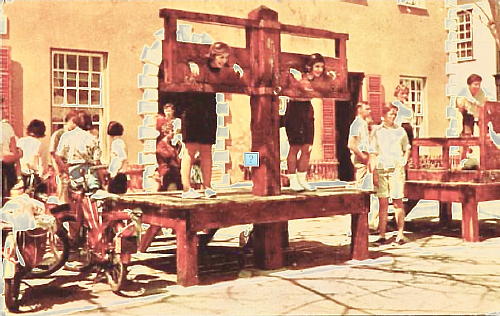 lured us to this island in winter for the annual painting of our warships. On Ireland Island
many of us got cracking and gave our ships a coating of red lead paint, finishing with a coat of the fleet favourite grey colour. When we
were granted shore leave, we had soccer matches on Ireland Island with the locals who didn't even wear shoes during play. This was a fun
experience for all.
lured us to this island in winter for the annual painting of our warships. On Ireland Island
many of us got cracking and gave our ships a coating of red lead paint, finishing with a coat of the fleet favourite grey colour. When we
were granted shore leave, we had soccer matches on Ireland Island with the locals who didn't even wear shoes during play. This was a fun
experience for all.
We thoroughly enjoyed visiting the quaint capital of Hamilton, as well as the many beaches all covered in pink sand. I especially liked
St. George Island which had some amazing features. In the main square they had some strange 1700's relics. There were "stocks" which
was a wooden framework on a post with holes for hands and head.
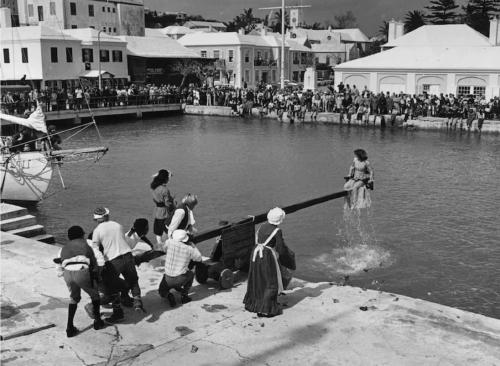 These stocks were used to lock up prisoners and to expose them to weather as punishment.
Also, a "dunking stool" with a pool of water, for nagging or gossiping women.
These stocks were used to lock up prisoners and to expose them to weather as punishment.
Also, a "dunking stool" with a pool of water, for nagging or gossiping women.
We also visited a wonderful place on the St. George island, called the Gunpowder Tavern. It is located in a high natural cavern which was originally used to store gunpowder in the 1700's, before in modern days when it became a fancy restaurant. On my visits, the restaurant featured waiters in bright red uniforms who would escort you inside along an entrance lined with large live torches. Quite a spectacular experience! Bermuda is a marvelous island, one which I will never forget.
Another especially memorable experience on Haida was her final voyage. We sailed to the Great Lakes in the summer of 1963. It was quite a change sailing up the St. Lawrence Seaway in fresh water, through locks. But it was more than that. We stopped at various spots along the way, so the crew from the eastern Canadian provinces were especially thrilled. One of the highlights was sailing up the Saguenay River to Chicoutimi Quebec. We didn't need to pay for a whale watching tour, the river was full of Beluga whales along the way. We were allowed shore leave in Chicoutimi which was a delight.
Sailing south was a slow trip and we were soon berthed at HMCS Star in Hamilton Ontario. It was the first time I was on a ship where we welcomed people onboard, hundreds of them. I was able to invite my entire family onboard and sail out onto Lake Ontario for an hour. It was especially meaningful for my Father when I told him HMCS Haida and HMCS Huron had been in the English Channel guarding his company of soldiers as Canadians were pouring into Normandy in the days following D-Day in 1944. Our Captain took the ship up to at least 20 knots during our sailing on Lake Ontario.
We later sailed to Toronto where the visiting crowds were even greater that in Hamilton. When I left the ship for shore leave one evening, I had to wait a bit for a cab. I was waiting with a couple of guys who I recognized immediately. I almost fell over when they asked me if I wanted to share a cab downtown. They were none other than George Armstrong, the longtime Captain of the Toronto Maple Leafs hockey team, and their greatest coach, and the team's greatest player ever, Davy Keon (who was a rookie then). Their team was in the middle of the three sequential years as Stanley Cup Champions. In the cab for the next 15 minutes we had a nice chat about Haida and about George taking young Davy for a night out on the town. What a thrill.
As usual, good things come to an end, and we headed back to Halifax. But this time to Bedford Basin across from the Halifax Harbour where Haida would be decommissioned after 20 years of service. It was sad and everyone in the Canadian Navy felt it. It wasn't long before crew members began to disappear and join their new ships. I was assigned to another wartime ship, HMCS Lanark.
While awaiting Lanark’s return to harbour, I was sent to HMCS Stadacona for a few days to stay and to take a few classroom sessions. During a mid-afternoon session on Friday November 22, 1963, the lecture was interrupted and the instructor disappeared for a few minutes. When he returned we were told President John Kennedy of the United States had just been seriously wounded during his motorcade drive through Dallas in Texas. He was alive, and was being rushed to hospital. News would follow soon. The class was suspended and we sat waiting to hear a further news update.
We were totally shocked to hear what had happened, since he was a popular president and was quite famous. He had avoided a world-wide nuclear war a year earlier when he stood up to Russia's Nikita Khrushchev and peacefully ended the Cuban Missile Crisis. I had witnessed that feat sitting nervously off the coast of Cuba on HMCS Huron.
We didn't have to wait long for the news of the president's condition – less than an hour later, the president had died in hospital. It was a sad day. Many events I experienced in the Navy shaped my life. This was definitely one of them, right alongside the Apollo 11 moon landing which occurred six years later in civilian life.
Canada's 'Fightingest Ship'
On May 26, 2018 HMCS Haida was
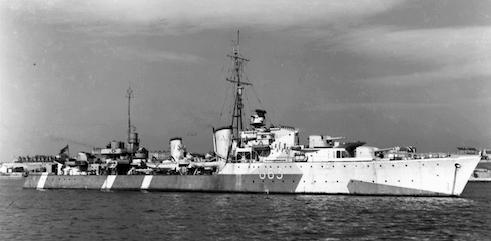 designated flagship of the Royal Canadian Navy to honour
the courageous spirit of this legendary destroyer and all those
who proudly served in her.
designated flagship of the Royal Canadian Navy to honour
the courageous spirit of this legendary destroyer and all those
who proudly served in her.
Haida is the last remaining Second World War Tribal-class destroyer in the world. Moored in Hamilton, Ont., it is now a National Historic Site managed by Parks Canada, welcoming visitors to learn about Canada’s remarkable naval history.
Given that the RCN is a destroyer navy with 108 years of service to Canada, Haida, as the Navy's flagship, is the very embodiment of the history, valour and fearless dedication of the women and men who serve Canada at sea. Haida is a physical testament to the RCN's long history as a fighting force and now stands as a permanent reminder of the sacrifice, resolve and courage of Canada's sailors.
Known as Canada's "fightingest ship," Haida sank more surface tonnage than any other RCN ship during the Second World War and later joined the "Trainbusters Club" during the Korean War. Haida's legacy is steeped in Battle Honours: The Arctic between 1943 and 1945; English Channel, Normandy and Biscay in 1944; and Korea from 1952 to 1953.
From: RCN flagship: HMCS Haida, Canada's "fightingest ship".
Can you provide comments or corrections?
Please email Charlie Dobie.